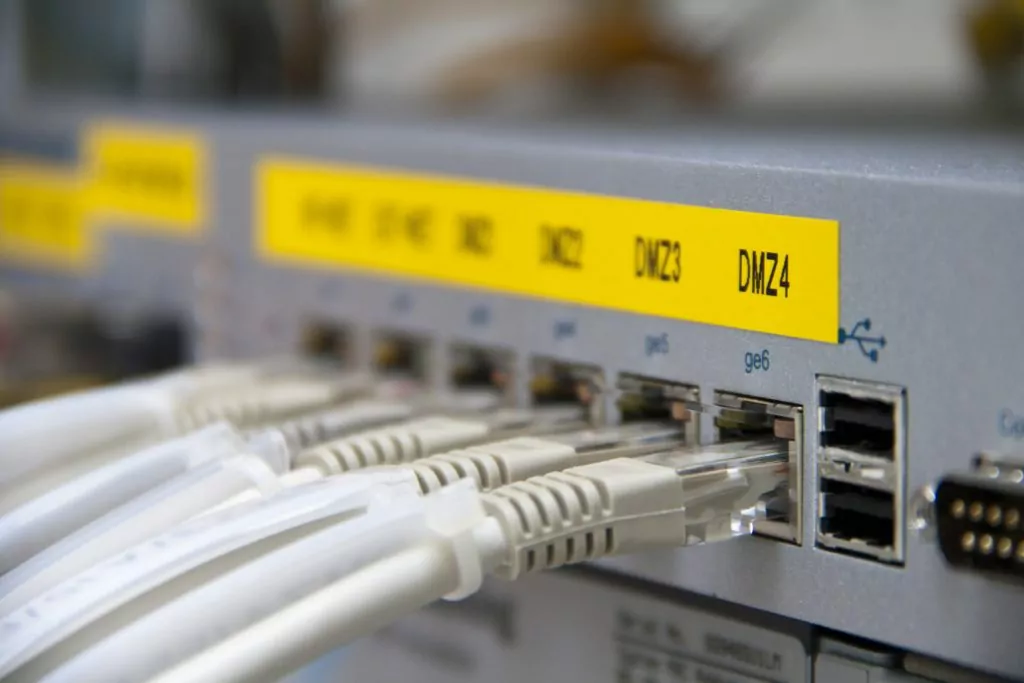Have you stumbled upon terms like “DMZ” or “port forwarding” and thought, “Wait, what?” You’re not alone. The whole DMZ vs port forwarding discussion can feel like you’ve walked into a Star Wars movie halfway through. But don’t sweat it! At Tech With Tech, we’re all about breaking down the geek speak into plain English. Stick around, and we’ll dive into this topic together, making sure you walk away with a clear picture.
If you want to learn all about difference between a DMZ and port forwarding, then this article is for you.
Let’s get started!
Understanding Security for DMZ vs Port Forwarding
We browse the Internet without a care in the world.
Need a new desk? Go online.
Getting tired of coming up with recipes for lunch? Search online.

We know that we can find almost any piece of information on any topic online. Even when we can’t find the topic we need directly, there’s always an opinion about it on forums, blogs, etc.
There we have it, an abundant source of information and misinformation. The Internet is full of facts, fact-checkers, opinions, nonsense, etc. It’s fun. It’s ubiquitous. We have learned to live with it, and sometimes a day can’t go by without it.
However, we also need to be aware of the dangers of the Internet:
- Hackers
- Malware
- Fake news
There are Internet security standards in place. But, they are specific for every country, which can lead to problems. To achieve optimal security, there must be global Internet security standards.
So, Internet security is quite important, and we need to be aware of the risks of using the Internet and how Internet security works.
How Does Internet Security Work?
The information transmitted through networks of networks then has to go through various channels to reach its destination. So now, the information we send has to be secure because we don’t want our information falling into the wrong hands.
This is where the brilliance of HTTPS (Hypertext Transfer Protocol Secure) comes in. HTTP is the basic version of the protocol, but with an “S” at the end, you can rest assured that you’re browsing a secure website.
The browsers and web servers use the protocol to communicate, and it’s secure because it uses certificates and encryption. What these do is scramble the data as it is transmitted across the Internet, and then they reassemble it when it reaches the destination.
This is what makes the information we send “uncatchable.” Imagine a hunter trying to shoot a flying bird. He shoots towards the bird, but the bird then disassembles and reassembles as the bullet goes through. It’s similar to the way our data travels the Internet.
This is a stress-reliever. There are other methods of making the network even more secure such as DMZ (Demilitarized Zone) vs Port Forwarding.
What Are DMZ and Port Forwarding?
When we speak about Internet security, we often come across DMZ vs Port Forwarding. They both improve our security on the Internet. The difference is in the way they improve our network’s security.
Demilitarized Zone Security
The DMZ is a perimeter network, another subnetwork that is exposed to the Internet. When you have your local area network (LAN) or wireless local area network (WLAN), the DMZ is the part of the network accessible by the public.

Imagine a dam. On one side, we have a large body of water, and on the other side, we have a stream. The dam is the DMZ. It’s keeping the water at bay and just letting a small quantity pass through, the quantity we need.
Enterprises, organizations, and businesses usually use dMZs.
So, all the services that businesses or organizations provide to users outside the internal network are in the DMZ:
- VoIP servers
- Mail servers
- Web servers
The DMZ can be set up to have one or two firewalls protecting it, similar to a trench on the battlefield. One firewall between the business’s LAN and the DMZ; and another firewall between the Internet and the DMZ.
Now, a DMZ host is different from a DMZ. When setting up a DMZ host, we set up one IP address to be accessible externally. It is not a part of the network, such as a web server or a mail server.
Port Forwarding Security
When speaking about networks, Port Forwarding is kind of a communication bridge between IP addresses. It lets computers on the Internet connect to computers in a private network.
Port Forwarding works similarly to a DMZ host. Certain port numbers are assigned for specific functions.
An administrator can assign one port number to communicate with a service in a private network.

This port number is important to external users because they need it to communicate with this service.
It can be used to run a game server that is available to the public within a private local area network, or it can be used to run an HTTP server in the same network.
The best part is that with Port Forwarding, we can eliminate the need for using firewalls. Because there’s only one port that an external network can access.
So, DMZ vs Port Forwarding differ because the DMZ is a zone, just like the name indicates, while Port Forwarding is a method.
The Difference Between DMZ and Port Forwarding
To make understanding all this easy to understand here’s the difference between DMZ and port forwarding in the simplest terms:
A DMZ is a small, isolated network positioned between the Internet and a private network.
Through port forwarding, a router allows an external user to reach a port on a private IP address (inside a LAN) from the outside.
A DMZ is a network, while port forwarding is a method of granting access to a network.
Setting Up Port Forwarding
With most modems and hubs, you can easily set up Port Forwarding. However, the DMZ host function is somewhat tricky and can come with a lot of bugs.
The safest bet is setting up Port Forwarding. This is because there are fewer reported issues regarding this. So, how do we set it up using different routers or modems?
ZTE H268A Router Port Forwarding
The router is secure and secures our network because it blocks off incoming internet connections. As a result, we have control over which apps can access our network.
Sometimes, we need an app to have access to our network to use it. This can be unblocked by opening ports on the ZTE H268A router by choosing specific ports for an IP address.
To do this, we need to set up a static IP address on the device we are forwarding ports to. So, how do we do that?
We go to the Start Menu > Control Panel > Network and Sharing Center. Then, we click on Change adapter settings and right-click on Wi-Fi or Local Area Connection.
We then click on properties, select the one that says “Internet Protocol Version 4 (TCP/IPv4).” Next, click on properties and select Use the following IP address. Next, we enter the IP address, the subnet mask, the default gateway, the DNS server and hit “Ok.”
Voila, you have a static IP address now.
Also Don’t Miss: ISP Blocking Port Forwarding: How to Know?
After this is done, we need to log into our ZTE H268A router. First, type in the router’s IP address into your browser (it’s located on the router, and it looks something like this: 198.0.1.162).
The default username and password for almost every router is “admin.” Just type it in, and you’re logged into your router. If that doesn’t work, check out the back of your router or contact your ISP.
From there, you can click on the Internet tab and then the security tab on the left side of the screen. Next, you’ll be able to see the Port Forwarding tab in the middle of the screen. Click on this tab.
Click on Create New Item, and the radio button will be there. Make sure it’s labeled On. The next thing you need to do is come up with a name for it. You can pick whichever name you want.
Next, you’ll be able to see a Protocol dropdown box. Again, it’s best to select Both in this case, if available. You’ll need to select TCP (Transmission Control Protocol) or UDP (User Datagram Protocol) if it’s not available. In this case, you’ll need to create two separate entries.
After that, you need to enter the static IP address you created in the LAN Host box. You can now enter the port number into the left WAN Port and the right WAN Port boxes. This will forward one port.
The same number goes into the WAN Port boxes and the LAN Host Port boxes. Then you hit Apply, and it’s done. You now have one port that is accessible from external networks.
The setup is quite similar for the ZTE MF910 mobile hotspot. Also, when it comes to private users, we usually use this method for online gaming.
Netcomm Modem Port Forwarding
The same applies to the Netcomm modem. We enter the IP address into our browser. That way, we get access to the modem.
The password and username are both “admin.” However, the steps are a little different as we need to go to the Advanced tab on the left side and click on Port fw.
From there, we need to check Enable Port Forwarding, designate a description in the Description box, such as PS4 or Xbox. Then, in the box that says Local IP, we put in the static IP address we created.
Then, we set the protocol to Both, and it is enabled. Finally, we type in the port number, and it’s done. The port number is usually located at the end of an IP address 198.0.16.1:80.
Xplornet Hub Port Forwarding and DMZ
The Xplornet Hub comes with advanced features such as DMZ and Port Forwarding. We can find them in the Advanced Networking Features tab.
The access to these is quite similar to all the other routers. The only difference is that it is a hub, but it still has its IP address, and the default username and password are also “admin.”
Make sure to remember that routers usually have a DMZ setup option as well.
Setting Up a DMZ
Now that we’ve learned how to set up Port Forwarding, setting up a DMZ should be an even easier task.
When we log into our router, modem, or hub, we go to the Advanced Setup tab. Bear in mind that it can be a different tab according to the type of hardware we’re using.

When we enter the Advanced Setup tab, we need to navigate to the NAT (Network Address Translation) tab. There, we’ll be able to see the DMZ button.
We need to click on it, and we see the Enable circle. Once we click on that, the only thing left to do is type in that static IP address into the DMZ Host IP Address.
Finally, we need to click on Apply, and we’re done.
We have a DMZ host. Make sure to remember that this is much like Port Forwarding because a DMZ host and a DMZ are not the same things.
When it comes to security, both of these serve their purpose, and you can control the flow to your internal network from external sources using them.
So, what are those Internet security risks that are beyond those layers of protection?
Network Security Risks
The most common network security risks are computer viruses which can corrupt and delete data on our machines.
Imagine working on yearly sales reports and a virus enters the network. It has the capability to wipe out everything that we have on that network.
Hackers can also cause quite a lot of damage from anywhere in the world. If they break into the network, they can steal data, sensitive information, etc.
The most important thing is always education. Sometimes, we breach our own security without even knowing it. So it’s best to educate ourselves on how we can protect our networks.


